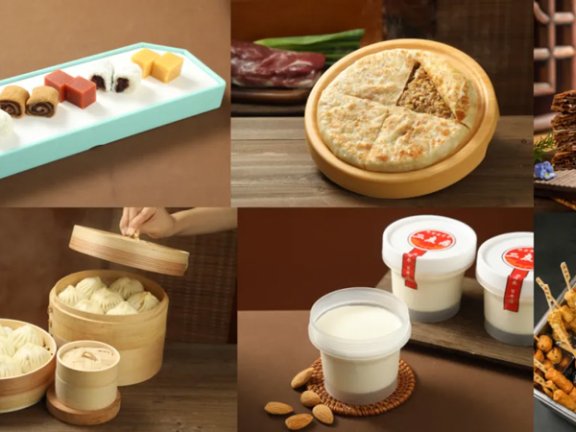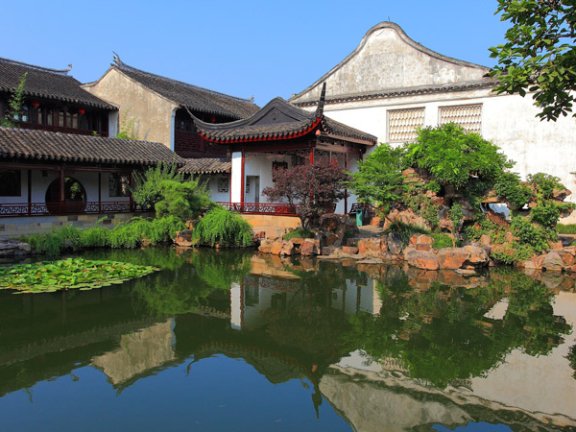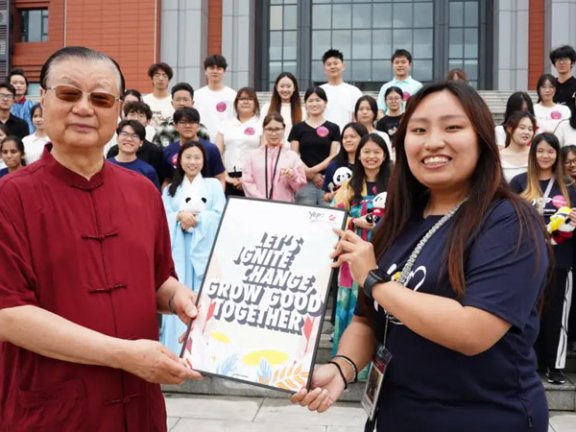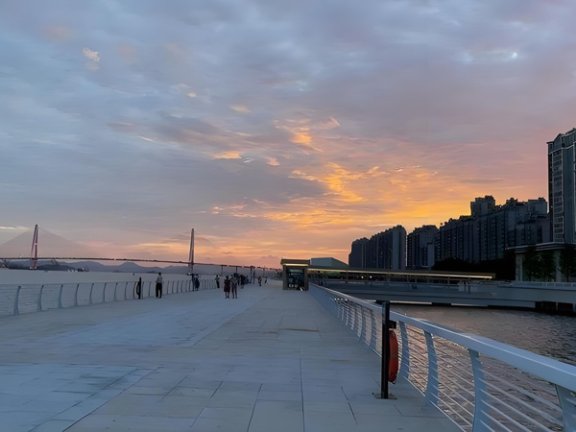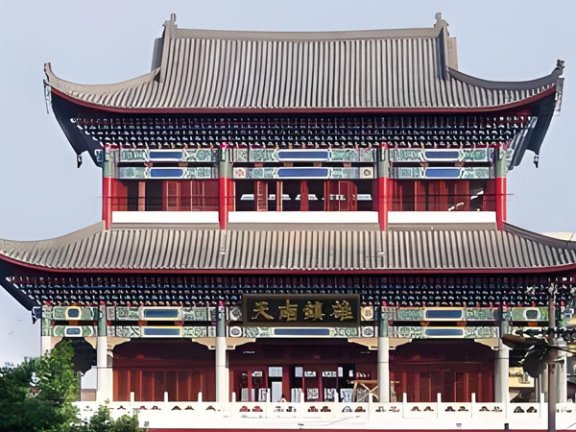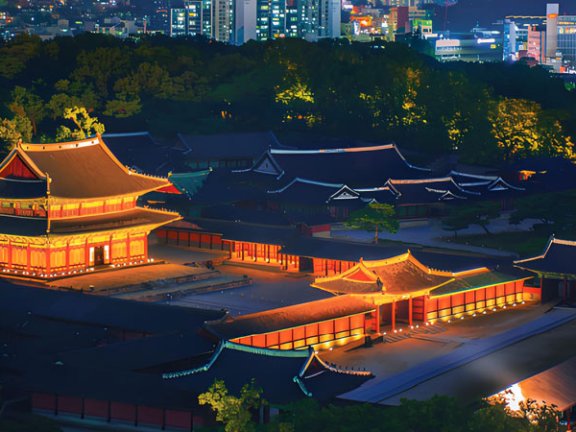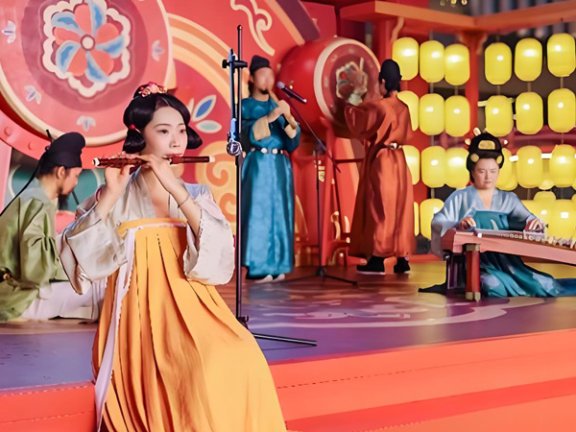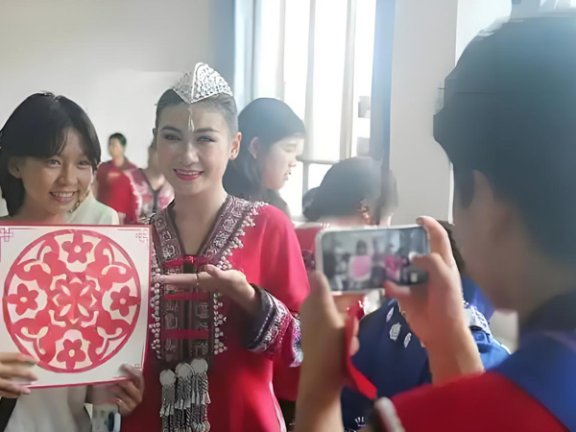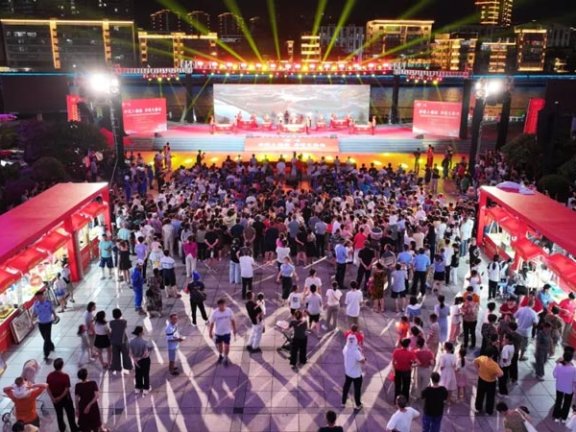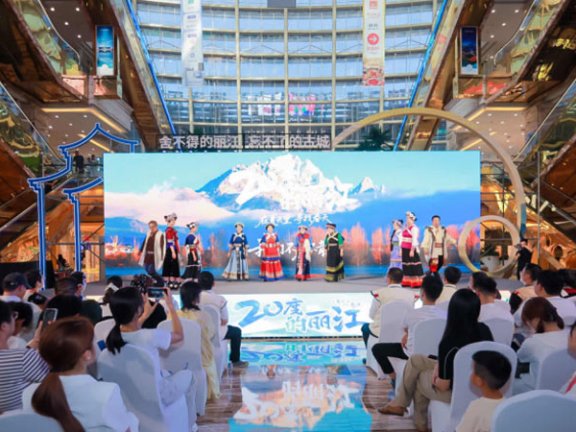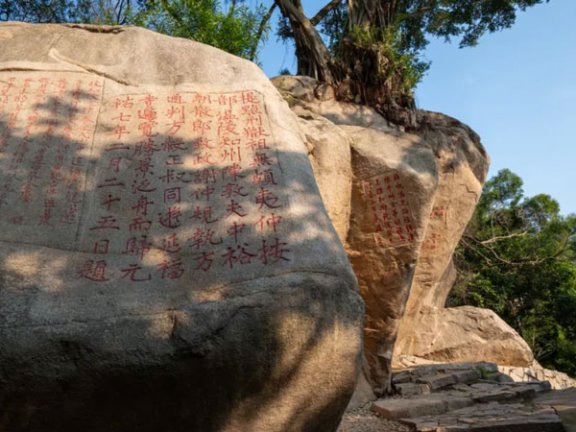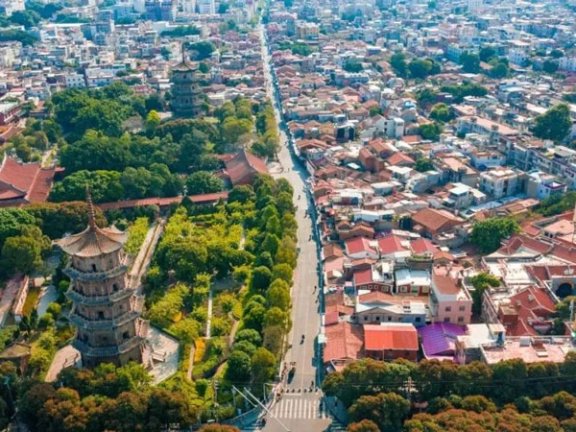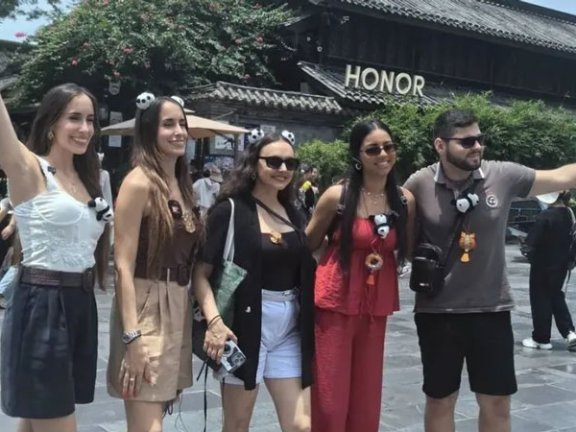-
Discovering the She Ethnic Group Through Fujian's Highlands!
In the lush landscapes of Fujian, a vibrant cultural wave is capturing hearts and headlines. The She (畲) people, an ethnic group with a rich history of migration and resilience, are stepping into the spotlight. Recently, a feature in China National Tourism (中国国家旅游) magazine, accompanied by actress Song Yi (宋轶) adorned in traditional She attire, has ignited widespread fascination. She, known for her roles in historical dramas, immersed herself in the She community, donning the iconic Phoenix Dress and sharing the experience with millions online. This isn't just a fashion moment; it's a gateway into a world where ancient traditions thrive amid modern times. The She, who call themselves "Shanha" (山哈) meaning "guests of the mountains," have carved out a unique identity through centuries of adaptation. Their story unfolds in remote villages nestled among Fujian's rolling hills, where every aspect of life, from architecture to cuisine, reflects a deep connection to nature and heritage. As interest grows, people are drawn not only to the visual splendor but to the profound human stories behind the culture. Phoenix Attire The Phoenix Dress is more than clothing; it's a wearable symbol of She identity. Inspired by reverence for the phoenix totem, this ensemble… -
A Culinary Journey to the West in Beijing
This September, a unique event is transforming a corner of Beijing's Shougang Park (北京首钢园) into a vibrant crossroads of food, folklore, and fun. The "Wuhuatianbao·Xiyou Shengyan" (物华天宝·西游盛宴) food market is more than just a place to eat; it's a creative playground where China's classic culinary names shake hands with one of its most beloved stories, creating an unforgettable fusion of taste and tale. This innovative concept aims to bridge generations, inviting both those who grew up with the legend and newcomers to experience it in a wholly original way. Running from September 10–14 as part of the 2025 China International Fair for Trade in Services (CIFTIS), this market is the brainchild of Beijing Huatian Food Group (北京华天饮食集团). It brings together a roster of the city's most famous time-honored restaurants for a collaborative experiment, all themed around the iconic 1999 CCTV animated series Journey to the West. The choice of Shougang Park, a symbol of industrial transformation, as the venue is particularly apt, echoing the event's own theme of reinventing tradition for a modern audience. The industrial backdrop provides a striking contrast to the mythical world being created, enhancing the sense of entering a special, separate realm. Old Brands, New Roles Forget…- 0
- 0
- 54
-
A Guide to Chongqing's Wild Heart and Fiery Plate
Chongqing, a metropolis renowned for its pivotal historical role and modern urban energy, reveals its truest essence not in its cityscape but in the breathtaking natural and cultural landscapes that surround it. This guide ventures beyond the urban sprawl to uncover ten exceptional natural escapes, each offering a unique window into the region's soul. 1. Chongqing's Wild Heart: 10 Natural Escapes Chongqing, shaped by three historic capitalships and pivotal wartime resistance, reveals its soul beyond the urban sprawl. While the revolutionary spirit of Hong Crag resonates, the surrounding landscapes offer profound tranquility and awe. This guide highlights ten natural wonders within reach for enriching day trips. Each presents a distinct facet of the region's diverse beauty, from mist-shrouded peaks echoing ancient battles to vibrant ethnic traditions thriving in mountain towns. Discover these escapes, where nature's grandeur meets enduring culture. 1.1 Borderless Horizons Xiushan's (秀山) Chuanhegai Scenic Area (川河盖风景区) sits just 15 kilometers from the county town. Its unique plateau landscape borders Hunan Province, with the Yezhuping (野竹坪) area reaching into Chongqing like a peninsula. The historic Taiping Township (太平乡场) market street literally straddles the provincial line, a century-old symbol of connection. On clear days, the plateau offers breathtaking views across…- 0
- 0
- 33
-
Yunnan Summer Travel Handbook: Dive Into Nature and Culture Magic
Forget the standard tourist checklist. Yunnan is not a destination to be simply seen; it is a sensory awakening waiting to be experienced. This is a land where nature writes poetry across dramatic landscapes—from stone forests clawing at the sky to serene lakes mirroring snow-capped peaks. It's a place where ancient towns hum with centuries of stories, and vibrant traditions are woven into the very slopes of the mountains. To travel here is to step into a living tapestry, a breathtaking dance of earth, water, and sky. Pack your curiosity, leave your expectations behind, and prepare to be surprised by the wild heartbeat of eternal spring. 1. Yunnan's Wild Heartbeat Forget guidebooks. Yunnan isn't a checklist; it's a sensory awakening. Imagine stone forests clawing skyward, ancient towns humming with stories, lakes mirroring snow-capped giants, and traditions woven into mountain slopes. This isn't just travel; it's stepping into a living tapestry where earth, water, and sky perform an ancient dance. Pack curiosity, leave expectations behind, and let the land of eternal spring surprise you. 1.1 Shilin (石林) Step into a world sculpted by epochs. Shilin isn't merely rocks; it's a petrified ocean frozen mid-storm. Towering limestone pillars, resembling mythical beasts or…- 0
- 0
- 49
-
Anhui: Where Nature’s Dances with Centuries of Culture
Nestled between mist-shrouded peaks and time-honored traditions, Anhui reveals itself not just as a destination, but as an experience—where nature’s quiet grandeur merges seamlessly with a culture carved by centuries. Here, mountains breathe, villages dream, and every flavor tells a story. 1. 6 Canvases of Wonder 1.1 Huangshan (黄山) Some places speak without words. Huangshan whispers through stone. Granite peaks pierce shifting clouds like ancient brushstrokes. These mountains breathe. Watch mist curl around twisted pines clinging defiantly to cliffs. Sunlight fractures on dew-heavy branches, scattering diamonds before your eyes. Dawn here paints the sky in watercolor washes – peach, lavender, gold. Those patient enough witness halos of light encircling their shadow on the clouds below. This realm feels sculpted by wind and time, not human hands. Paths wind past rocks resembling mythical beasts frozen mid-roar. Natural hot springs steam quietly at the mountain’s feet, offering warmth after cool summit winds. Come winter, ice glazes every branch, transforming the forest into crystal. Huangshan isn’t scenery. It is atmosphere. 1.2 Hongcun (宏村) Southward, stillness reigns. Hongcun floats. Its whitewashed walls and ink-black tiles mirror perfectly in the crescent-shaped Moon Pond. Rain turns pathways into liquid obsidian, reflecting curved eaves and carved wooden…- 0
- 0
- 59
-
Suzhou: Where Classical Gardens and Living Culture Intertwine
Nestled in the heart of Jiangnan, Suzhou emerges as a living canvas where ancient design breathes through time. This city unfolds like an open-air museum, celebrated for its UNESCO-listed classical gardens—not as static relics, but as dynamic spaces where nature and philosophy merge. Within their walls, miniature mountains and reflective ponds capture the essence of each season, while beyond, the pulse of daily life echoes through narrow, historic lanes. From the delicate melodies of Kunju (昆剧) opera floating over water to the intimate storytelling of Pingtan (评弹) in cozy teahouses, Suzhou engages all senses. Its culinary traditions, rooted in seasonal harmony, offer a taste of the region’s rhythm. Here, every garden path, cobbled alley, and steamy bowl tells a story—inviting travelers to wander, contemplate, and immerse in a living culture where past and present gracefully intertwine. 1. Suzhou's Living Canvases: Where Design Breathes 1.1 Suzhou's Gardens: Four Seasons, One Step Suzhou unfolds like a living museum, its cityscape woven with 108 classical gardens. No single visit can capture them all, demanding thoughtful selection. These are not static relics but dynamic spaces where the ancients bottled nature's essence: stone mimicking mountains, ponds mirroring lakes, ensuring every season painted new scenes within…- 0
- 0
- 66
-
Singaporean Students Immerse in Chengdu's Culture at Jin Cheng College
On July 5th, 2025, a vibrant group of 35 students from Singapore National University and Nanyang Technological University arrived at Jin Cheng (锦城) College in Chengdu. Their half-day visit promised cultural discovery and connection. Greeted warmly by the college leadership, including Founder Professor Zou Guangyan and President Professor Wang Yali, the Singaporean delegation joined Jin Cheng students for an exploration of campus life and shared traditions. The atmosphere buzzed with anticipation for the experiences ahead: discovering campus landmarks, engaging in meaningful dialogue, and diving into hands-on cultural activities designed to foster genuine connection between the young people of both nations. Moments of Shared Discovery The initial encounter dissolved any hesitation. Ice-breaking games sparked laughter and conversation, instantly bridging the gap between the Singaporean visitors and their Jin Cheng hosts. Guided by local students, the group explored the campus heart, including the Entrepreneurship Hall and the History & Alumni Museum. This journey through Jin Cheng's spaces provided context for the institution's spirit. A formal welcome followed in Room Z203 of the Siwei Building. Professor Zou Guangyan (邹广严) expressed heartfelt enthusiasm for the exchange, emphasizing its value for educational collaboration and enduring friendship between Singapore and China. He extended an open invitation…- 0
- 0
- 72
-
Shantou Culture, Tourism and Fashion Week is About to Start
From July 14 to 20, Shantou’s skyline will ignite with the inaugural "Chaos·Surging" Cultural Tourism Fashion Week. Centered along the Inner Harbor waterfront, events will transform landmarks like the Chaoshan History & Culture Expo Center and Xiaogongyuan Pier into dynamic stages for culture, design, and community. This festival merges intangible heritage with contemporary flair, positioning Shantou as a nexus of creative innovation along China’s southeastern coast. Fusion Runway: Heritage Reimagined National intangible heritage—paper-cutting and woodcarving—takes center stage as local artisans collaborate with avant-garde designers. These crafts evolve into wearable art, where delicate cut-paper motifs contrast with structured silhouettes. captures a gown featuring laser-cut woodcarving patterns layered over modern textiles, symbolizing dialogue across eras. Each piece narrates Chaoshan’s legacy while defying tradition’s boundaries. The runway becomes a cultural laboratory. Designers like Lin Wei embed porcelain-blue gradients inspired by Chaozhou kilns into minimalist tailoring, while tech-infused fabrics mimic the translucence of rice-paper lanterns. This synergy transcends aesthetics, offering a blueprint for preserving craftsmanship through relevance. Audiences witness how heritage fuels innovation, not nostalgia. Night Market Alchemy: Sips and Sounds At Chaoren Wharf, the "Tea Genesis" pop-up redefines tea culture. Chengchuan Zhicha and Hengdao Yipin launch fusion drinks like oolong-espresso tonics and lychee-infused…- 0
- 0
- 111
-
Jian'ou: Ancient City, Tasty Bites, Flagpole and Umbrella Shows
Forget dusty relics and silent museums. Jian'ou (建瓯), cradled in North Fujian's lush mountains, isn't just a place on a map; it's the vibrant, living origin of "Fujian" itself. This ancient city, once the mighty prefectural seat of Jianzhou, pulses with over three millennia of uninterrupted history. Its streets whisper tales from the founding of Fujian's first commandery, its first prefecture, and its first superior prefecture. Known undisputedly as the "First Prefecture of the Eight Min Regions," Jian'ou offers more than monuments – it offers an immersion into the enduring spirit of a civilization. Here, history isn't confined to textbooks; it resonates in the rhythm of daily life, the texture of weathered stone, and the aroma drifting from centuries-old kitchens. Footsteps Echoing Through Millennia Walking Jian'ou’s core is stepping onto the stage where Fujian’s story began. The weight of history is tangible, worn smooth into the very flagstones. Imagine Buddhist monks meticulously carving scriptures onto steles during the Tang dynasty, or Song administrators drafting decrees that shaped a region. This ground witnessed the birth of institutions that governed vast territories long before Fuzhou or Xiamen rose to prominence. The city’s layout, still discernible, reflects its former administrative grandeur. It’s a…- 0
- 0
- 137
-
Hanfu's Global Embrace in China's Ancient Towns
Summer 2025 witnesses a cultural phenomenon reshaping China’s tourism landscape. From mist-shrouded villages in Anhui to canal-lined streets of Shaoxing (绍兴), international visitors are trading T-shirts for Tang dynasty robes. This sartorial shift transcends fashion—it’s a tactile dialogue with history. As Indian student Adnan explores Keqiao Ancient Town, his crimson-sleeved arms gesture toward stone bridges, embodying a silent conversation between eras. Beyond Instagram moments, this trend fuels local economies and rewrites cultural exchange. Threads of Curiosity Adnan’s journey began with a simple observation: flowing sleeves against smartphone screens. "At home, we see hanfu in documentaries," he shares while adjusting his linen sash. "Touching embroidered phoenixes makes legends tangible." His family’s Shaoxing base became a springboard to Keqiao’s silk vendors, where textures bridged his Indian heritage with Ming dynasty motifs. Near Huangshan’s Xixinan Village, Brazilian siblings Maria and Pedro discovered shared symbolism. "Our Carnaval feathers mirror these crane patterns," Pedro notes, tracing gold-threaded birds. Their guide contextualized each stitch: "Cloud collars symbolize heaven’s embrace," she explained, linking cosmology to craftsmanship. For German retiree Helga, the ritual itself resonated. Seated before a Qing-style dressing mirror, artisans transformed her silver braid into coiled palace hairstyles. "This combing ceremony," she reflects, "feels like ancestral…- 0
- 0
- 64
-
2025 Beijing Boosts Cuisine to Spur Consumption
Summer's heat ignites Beijing's dining scene, but this year, traditional discounts take a backseat to cultural immersion. Restaurants report a 5% surge in both customers and revenue compared to last summer, driven by innovative blends of heritage, storytelling, and local flavors. From noodle workshops in bustling hutongs to panda-themed feasts and lakeside craft markets, eateries are transforming meals into multidimensional journeys. This shift responds to travelers craving authentic connections beyond taste, proving that Beijing’s culinary identity thrives when chefs become culture keepers. Noodle Literacy Takes Root At Fangzhuang 69 Noodle House, queues stretch longer as tourists master the art of eating Zhajiangmian (炸酱面). Servers demonstrate the "three-step ritual": coating noodles with oil, ladling rich soybean paste, and artfully arranging 12 vibrant seasonal toppings like shredded cucumber, radish, and young garlic. Patrons aren’t just eating; they’re decoding centuries of northern Chinese culinary tradition. Demand for cultural context is palpable. Over 40% of visitors now ask about noodle history and vegetable symbolism, prompting staff training in storytelling techniques. Waiters explain fermentation secrets of the savory brown sauce and the significance of seasonal toppings, even offering key phrases in multiple languages. This cultural appetite has tangible impacts. Monthly garlic consumption alone exceeds 15…- 0
- 0
- 57
-
Seoul Eases Access: China Group Tours Get Visa-Free Future
South Korea is poised to significantly boost its tourism sector by potentially extending visa-free entry for Chinese group visitors indefinitely. This strategic move, currently under final review by government ministries including Justice and Culture, aims to accelerate economic recovery by targeting the crucial Chinese market. Building on a planned short-term trial starting late 2025, the policy could become permanent from 2026 onwards, signaling a long-term commitment to welcoming Chinese travelers. Concurrently, authorities are exploring options to expand this benefit to individual tourists in the future, recognizing the substantial economic impact of Chinese visitation. Bilateral Tourism Surges Recent statistics highlight the strong rebound in travel between South Korea and China. During the first quarter of 2025 alone, 1.12 million Chinese tourists visited South Korea, constituting 28% of all international arrivals. This momentum builds on the 4.6 million Chinese visitors recorded in 2024, a significant jump from 2.02 million in 2023, though still below the 2019 peak. The reciprocal flow is equally robust, with 912,000 South Koreans traveling to China in the first four months of 2025, marking a 48.5% year-on-year increase. Demographic diversification is underway. Korean data shows retirees joining youth travelers to China, drawn by affordable high-speed rail passes and…- 0
- 0
- 89
-
Global Youth Redefine Rural China Through Shanghai's Countryside
A unique symphony of cultures unfolded recently in the lush landscapes of Shanghai's Jinshan district, as students from Egypt, Morocco, Vietnam, Russia, South Korea, Mongolia, Nigeria, and China embarked on a journey challenging conventional perceptions of rural life. Organized by the Communist Youth League of Jinshan District and Shanghai International Studies University (SISU), this immersive experience revealed a dynamic China where ancient traditions harmonize with cutting-edge innovation and global community thrives. Beyond the picturesque lotus ponds and waterways, these young explorers discovered a countryside pulsating with unexpected energy and opportunity, forging connections that transcended national borders through shared wonder and participation. Digital Nomads, Rural Roots Stepping into the Caojing Digital Nomad International Village, the international visitors encountered a startling fusion of pastoral beauty and modern work culture. They navigated serene paths along the shimmering Reservoir Central River, wandered through the lotus-filled Ouyu Park, and discovered professionals from across the globe working in a library ingeniously repurposed from abandoned buildings. "Here, the charm of the Jiangnan watertown coexists with pioneering lifestyles and community structures. Advanced infrastructure blends seamlessly with idyllic rural scenery, completely overturning my previous image of the Chinese countryside," remarked Bian Zhiyuan, a student from South Korea . This…- 0
- 0
- 75
-
Wuyi's Living Legacy: Mist-Shrouded Peaks and Ancient Wisdom
Beneath the watchful gaze of cinnabar cliffs, where the Nine Bend River carves poetry into stone, Wuyi Mountain transcends geography. This UNESCO dual-heritage site—a rare fusion of ecological marvel and cultural crucible—whispers eight centuries of philosophy in its rustling tea groves. When dawn mist clings to bamboo forests, the mountain reveals itself not as a relic, but as a breathing chronicle of China’s spiritual and natural soul. Footsteps in the Realm of Scholars A cobbled path near Thunder Rock echoes with scholarly debates. Here, Zhu Xi’s inscription The Past Flows Like This (逝者如斯) endures on moss-kissed stone—a 12th-century meditation on time’s current, mirrored in the relentless river below. The calligraphy’s bold strokes seem to ripple with the water, bridging Confucian thought and elemental truth. Nearby, Tea Boulder rises like nature’s altar midstream. Zhu Xi’s verse immortalizes this granite stage where scholars once sipped oolong amid steam and discourse. Though silent now, the rock radiates tranquility, its legacy steeped in leaves and ink. Further along, the restored Wuyi Retreat (武夷精舍) stands sentinel. Amid cedar-shaded courtyards, foundation stones mark where The Four Books took shape. Visitors tread where disciples parsed cosmic order, the air thick with intellectual ghosts. At Minyue Kingdom Ruins…- 0
- 0
- 129
-
Tang Dynasty Elegance Ignites Beijing's Night Economy Renaissance
Shoukai LONG Street transformed into a portal to ancient China during its spectacular second anniversary celebration, held June 28-29, 2025. Partnering with the Changping District government and leveraging cinematic inspiration, the event, themed "Tang Dynasty Elegance," propelled the district's "Night Economy 3.0" initiative to unprecedented heights. Over two pulsating nights, the open-air complex drew a staggering 120,000 visitors – a 50% surge from the previous year – generating over ¥6 million in sales (up 28.5%) and amassing 120 million social media impressions. This wasn't merely a festival; it was a cultural and commercial phenomenon, establishing Shoukai LONG Street as the undisputed epicenter of Beijing's northern nightlife and setting a new benchmark for experiential retail. Reimagining History Stepping onto Shoukai LONG Street felt like entering a meticulously crafted Tang Dynasty dreamscape. Architects and designers masterfully utilized the venue's layered terraces and expansive walkways. They reconstructed iconic scenes from beloved historical dramas, transporting visitors along the legendary Empress Yang Guifei's litchi delivery route. Vibrant vermillion hues dominated, accented by intricate Tang brocade patterns adorning facades and installations, subtly echoing imperial aesthetics while infusing artistry into the urban fabric. The centerpiece was a sprawling, immersive recreation of a Tang market district, exceeding a…- 0
- 0
- 77
-
Pu'er and Laotian Youth Exchange Through Tea and Coffee Culture
The recent conclusion of the second "Study in Pu'er" program marked another successful chapter in cultural diplomacy between China and Laos. Over six immersive days, 44 young ethnic Chinese students and teachers from Laos explored Pu'er's unique identity where ancient tea traditions meet vibrant coffee culture. Hosted in Yunnan's southwestern city bordering Laos, Vietnam, and Myanmar, the initiative builds on last year's inaugural program. Participants engaged deeply with Chinese heritage while discovering shared roots along the historic Tea Horse Road. Their experiences—from hands-on tea processing to collaborative art projects—forged personal connections that transcend borders. As one student noted, the taste of Pu'er tea lingered far longer than the beverage itself, symbolizing the program's enduring impact on cross-cultural understanding and friendship. Cultural Immersion Experiences Pu'er's dual identity as a global tea source and China's coffee capital provided rich learning grounds. Students explored specialized workshops where they witnessed traditional Pu'er tea production techniques. Song Fanghu (宋方浒), whose family works in Laos' tea sector, discovered distinct processing methods enhancing the tea's fragrance and aftertaste. "The depth of flavor here is remarkable," he observed, planning to share these techniques back home. Parallel coffee workshops revealed surprising versatility. Song Yuping (宋雨平) marveled at cascara—coffee cherry…- 0
- 0
- 61
-
Nanjing Intangible Cultural Carnival, Peace and Dragon Art
Summer in Fujian's misty mountains ignites with living traditions. Nanjing County, guardian of UNESCO-listed earthen Tulou fortresses, recently launched its inaugural Intangible Cultural Heritage Carnival alongside a vibrant summer tourism season. This fusion of ancient craftsmanship and contemporary celebration transforms historical sites into dynamic cultural hubs, where drumbeats resonate through centuries-old walls and artisanship breaks world records. The carnival isn't merely a festival; it's a testament to a community breathing new life into ancestral wisdom while forging global connections. Igniting the Cultural Flame The carnival commenced on July 4th at Nanjing Cultural Center, illuminated by projections showcasing the region’s emerald landscapes and intricate Tulou architecture. Provincial leaders, heritage scholars like Dr. Han Jie from Xiamen University, and guardians of fading crafts gathered as thunderous drum performances in Tulou Gu Yun: Welcoming Guests (土楼鼓韵▪迎客来) shook the auditorium. The rhythmic pulse embodied both reverence for the past and excitement for new beginnings. A highlight emerged with the unveiling of The Art of Tulou Construction (土楼营造技艺), a seminal book preserving vernacular building techniques nearly lost to time. Its release, alongside a documentary chronicling 100 Tulou structures, marked a milestone in scholarly preservation. When officials activated the carnival by pushing ceremonial rods, they symbolically…- 0
- 0
- 84
-
International Internet Celebrities Meet Slightly Tipsy Yantai
International voices echo through Yantai's sun-drenched valleys, drawn by the allure of its burgeoning wine culture. From July 2nd to 4th, a diverse cohort of global social media influencers and cultural enthusiasts descended upon Shandong's coastal gem, invited by China Daily, the Yantai Municipal Publicity Department, and the Commerce Bureau. Their mission: to experience firsthand the unique character of this "International Grape and Wine City." Representing nations like the United States, France, Russia, Italy, and Sri Lanka, these digital storytellers embarked on a journey beyond mere tasting, seeking the essence of Yantai's terroir and its people's passion. This immersive exploration promises to ripple across global platforms, showcasing a region rapidly carving its niche on the world wine map. Yantai's credentials are formidable: a foundational pillar of China's wine industry, its international stature was cemented in 2022 with its pioneering "Partnership" status in the Global Wine Tourism Organization (GWTO), followed by the prestigious "Global Wine Tourism Destination" award in 2023. Vines, Views, and Vinous Character The heart of the discovery lay in the rolling landscapes of Penglai's Qiushan Valley. At Longting Vineyard, the morning mist mingled with focused breaths as guests followed instructors in the graceful movements of Ba Duan Jin,…- 0
- 0
- 90
-
Huangshui National Resort Invites You to 21℃ Summer
Nestled high in Chongqing's mist-shrouded peaks, Huangshui National Tourist Resort emerges as an antidote to scorching summers. At 1500 meters above sea level, this alpine refuge maintains a perpetual 70°F (21°C) embrace, earning its "Natural Air-Conditioned City" moniker. Beyond temperature relief, it unfolds a tapestry of crystalline lakes, primeval forests, and vibrant Tujia traditions, transforming escape into profound discovery within its UNESCO-designated latitude. Nature's Masterpieces Moon Lake mirrors the heavens like liquid jade, its 57-acre surface reflecting dense pine forests. Morning transforms the reservoir into an ethereal landscape where kayakers glide through mist veils. As dusk paints the water gold, photographers capture shimmering light patterns unique to these highlands. Each paddle stroke reveals new perspectives on this human-made marvel. Sun Lake's vast 667 acres claim the title of Southwest China's highest freshwater body. Its transparent waters meet stringent Class I quality standards, revealing submerged rock formations. Visitors skim across the surface on motorboats or pedal water cycles along reed-fringed shores. The surrounding trails invite cyclists to explore microclimates where mountain breezes carry wildflower scents. The Emerald Forest (Bizika Green Palace) envelops travelers in 2,165 acres of old-growth woodland. Giant firs form natural cathedrals where sunlight filters through canopy layers. This…- 0
- 0
- 140
-
Escape the Sizzle: Discovering Lijiang’s 20°C Summer Sanctuary
As Chengdu's streets pulse with the fervor of the World Games and summer heat shimmers above spicy hotpot cauldrons, a playful "apology" echoes from the northwest. "Sorry, we only have 20 degrees!" declares Lijiang, China's ancient mountain jewel, extending an irresistible invitation to Sichuan's sweltering residents. This witty marketing campaign, blending humor with genuine hospitality, unveils a meticulously curated summer escape. Beyond the clever posters lies a tangible promise: mist-shrouded peaks, cobblestone lanes echoing with Naxi melodies, and a meticulously crafted "tourism gift box" designed exclusively for Sichuan travelers seeking refuge in nature's perfect climate. The Art of the "Cool" Apology Lijiang’s campaign masterstroke was framing its climatic advantage as a humorous mea culpa. Nine-panel posters playfully "regretted" the city’s inability to match Chengdu’s scorching temperatures or the thunderous energy of the World Games. Instead, they boasted of cool mountain breezes and ancient rhythms – a juxtaposition that sparked laughter and immediate connection. This viral "apology" transcended mere promotion. It acknowledged Chengdu’s vibrant summer energy while positioning Lijiang as its refreshing counterpart. Xu Lei, member of the Lijiang Gucheng District Party Committee, emphasized the deep kinship between Sichuan and Yunnan, framing the campaign as an act of familial hospitality rather…- 0
- 0
- 46
-
Quanzhou: The World Marine Trade Center of China
Quanzhou’s 22 UNESCO World Heritage sites aren’t mere ruins; they’re the beating heart of a 13th-century global trade metropolis where cultures converged like monsoon currents. When Marco Polo dubbed this port "Zaiton," he witnessed a city orchestrating maritime commerce from China to East Africa. The legacy lives in the moss-covered bridges where Arab traders once walked, the Taoist shrines where Song dynasty merchants prayed for fair winds, and the Islamic tombs whispering tales of Persian navigators. Each stone here is a page in humanity’s first playbook of globalization. Engineering Marvels That Defied Tides The Bridge Builders’ Legacy At Luoyang Bridge, engineers pioneered "raft foundations" and oyster-reinforced piers—medieval biotechnology enabling a 120-meter span across the roaring Luoyang River. Its "Moonlight Bodhisattva" carving still gazes seaward, guarding secrets of Song-era ingenuity. Nearby, Anping Bridge stretches five li (2.5 km), an engineering Everest using tide-assisted "floating beam" techniques. These arteries pulsed with silk and porcelain, linking hinterland kilns to waiting dhows. Ports That Tamed Oceans Shihu Dock’s trapezoidal stone platforms and Cizao Kiln’s dragon-shaped furnaces reveal an industrial ecosystem. Archaeologists uncovered Ming-era celadon shards beneath wharf stones—proof that docks doubled as bustling markets. At Zhenwu Temple, the 1533 "Devourer of Seas" stele looms…- 0
- 0
- 85
-
Public Restrooms in Quanzhou Become Cultural Canvases
Nestled within the ancient alleys of Quanzhou, a city steeped in maritime Silk Road history, an unexpected transformation is unfolding. Far from mundane utilities, 11 newly renovated public restrooms have emerged as cultural landmarks, seamlessly blending heritage craftsmanship with modern functionality. These structures—scattered across historical districts like Kui Xia Lane and Guan Dong Lane—reimagine urban sanitation as a dialogue between past and present, proving that even the most utilitarian spaces can embody a city’s soul. Architectural Poetry in Brick and Stone The bathrooms in Quanzhou pay tribute to the traditional culture of Fujian Province with exquisite craftsmanship. In Kuaijiang Lane, the walls display "out brick into stone", an ancient technique that embeds recycled bricks and local granite into the earthen walls.Each irregular pattern tells a story of demolition and rebirth, with materials sourced from dismantled ancestral homes—their weathered surfaces bearing witness to centuries of history. Nearby, Guan Dong Lane’s facility features the iconic "yan wei ji" (燕尾脊, swallowtail ridge), a curved roof silhouette symbolizing Minnan architecture. Bamboo lattices adorn its facade, casting dappled shadows that merge privacy with ventilation. This design transcends practicality: sunlight filtering through bamboo creates a meditative interplay of light and texture, inviting visitors to experience nature’s…- 0
- 0
- 88
-
Classic Two-day Tour Route of Quanzhou Ancient City
Stepping into Quanzhou is like entering a living theater where history and modernity dance in harmony. As a former hub of the world's maritime trade and the eastern starting point of the Maritime Silk Road, this ancient port city in China's Fujian province offers a captivating blend of cultural heritage, vibrant street life, and culinary delights. With its UNESCO World Heritage status, featuring 22 sites that narrate tales from the Song and Yuan dynasties, Quanzhou invites travelers on an immersive two-day adventure. Wander through centuries-old temples, bustling markets, and serene alleys, all while riding the iconic "little white" electric carts that whisk you between landmarks. Whether you're a history buff, a foodie, or a seeker of tranquility, this compact yet rich itinerary promises unforgettable moments—from dawn prayers at Taoist shrines to twilight feasts under lantern-lit skies. Embrace the city's rhythm, where every corner reveals stories of emperors, traders, and artisans, making it a perfect escape for a short getaway that feels timeless and transformative. Historic Landmarks Explored Begin your journey by arriving at Quanzhou Jinjiang International Airport or the high-speed rail station, easily accessible by public buses that drop you in the heart of the ancient city. Check into one…- 0
- 0
- 54
-
Chengdu's Cultural Symphony Leaves Greek Influencers Spellbound
Five prominent Greek content creators embarked on an unforgettable journey through Chengdu this week, immersing themselves in the vibrant tapestry of Sichuan's capital. Their five-day odyssey, commencing July 1st, offered a sensory feast blending ancient traditions with modern dynamism. From the tranquil morning rituals in People's Park to the dazzling lights of Chengdu’s futuristic skyline, the group documented their encounters with Chengdu's unique blend of relaxation and exhilaration. Their cameras captured moments steeped in heritage and buzzing contemporary energy, consistently punctuated by exclamations of "amazing" as they delved into the city’s renowned laid-back charm and profound cultural depths. This exploration promises to showcase Chengdu's allure to their vast European audience. Ancient Arts Come Alive The pulse of Chengdu’s daily life greeted the influencers at People's Park. By 9 AM, the park hummed with activity: groups practiced the graceful movements of Baduanjin, while others reclined in bamboo chairs at the iconic Heming Teahouse, savoring steaming cups of tea. The creators instantly connected with this embodiment of Chengdu’s famed leisure culture. A traditional sugar painting artist captivated them, deftly transforming molten sugar into intricate shapes like a delicate butterfly with swift strokes of a copper ladle. Later, at Heming Tea house, the…- 0
- 0
- 101
❯
Profile
Check-in
Message
Message
Search
Contact Us
Scan to open current page
Top
Checking in, please wait
Click for today's check-in bonus!
You have earned {{mission.data.mission.credit}} points today!
My Coupons
-
$CouponsLimitation of use:Expired and UnavailableLimitation of use:
before
Limitation of use:Permanently ValidCoupon ID:×Available for the following products: Available for the following products categories: Unrestricted use:For all products
No available coupons
Daily tasks completed:

